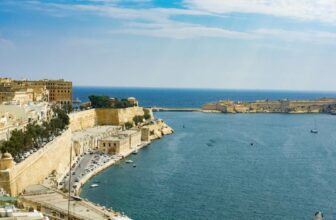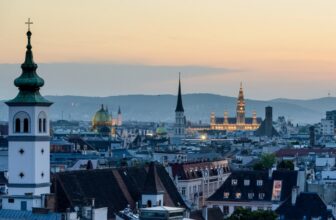Lisbon, Portugal’s beautiful and lively capital city, is known for its hot and vibrant style. The area is also honored with an abundance of significant landmarks, world-class exhibition halls, and a wide range of great activities. With all of these options, it’s OK if you’re wondering where the best places to visit in Lisbon are.
There are many choices, including the small streets of the old town, the river stroll, and h natural parks and gardens. If you take your time to enjoy Lisbon like a local, you’ll quickly feel drawn to its beauty and intriguing charm.
With some of the best European food and weather, Lisbon is blessed with sunshine gracing its entire coastline and tasty morsels to devour.
You have two choices: either you can research all of Lisbon’s places yourself, or you can keep reading to discover the already done work on the best spots to visit in Lisbon.
5 Must-See Places In Lisbon
Lisbon has seen a shift over the last couple of years, and there are now so many things to do here that it’s difficult to explore the whole city in just one trip. Its old cobbled streets, lovely wooden trams, clear river, and stony walls are all still there. But there is also a good deal of new sites to explore.
Chefs from across the globe are opening some of the finest restaurants in Lisbon, while local patrons have also elevated their standards. Bartenders from cities like London, Paris, and New York are joining Lisbon bars, fusing local and global inspirations.
Alfama
Alfama is considered to be one of Lisbon’s most traditional areas. It is famous for its Moroccan bases and was once filled with small streets, lanes, sides, and smaller buildings. All of this contributes to the idea that Alfama is a little town within the city. The Moroccan -type tower on top of the hill, which dates back to the 11th century, dominates this place.
What makes it so interesting is the small archaeological museum, the remains of a medieval palace, and the various cafés serving traditional food. Additionally, you must see the Portas do Sol, or ‘Gates to the Sun,’ which allows you to see the entire neighborhood.
Get Lost in the Winding Streets
Wandering the streets of Alfama is an incredible experience. You’ll quickly become immersed in its twisted lanes, so be sure to wear comfy shoes. What’s more, there are plenty of intriguing stores, pubs, and cafés to uncover along the way.
Take a little break and indulge in a ginjinha, a delightful cherry liqueur offered by old women directly from their houses. After that, have a simple coffee at a traditional Portuguese pastelaria.
Don’t forget a map or a navigation app on hand, just in case you need to find your way back to a main road or your accommodations.
Belém
Belém was an important seaport (especially during the Portuguese discoveries) and now offers a plethora of museums and historical landmarks. Mosteiro dos Jerónimos (Monastery of Jeromes) and Torre de Belém (Tower of Belém) are the most notable structures, both erected in the 16th century in what is known as the Manueline style.
This incorporates maritime aspects as well as large arches and twisted frames that form cornices, facades, and vaults. If you’re looking for something more exotic, you can visit the almost-forgotten Botanical Gardens of Belém, which hold various shrub species from all over the world.
Visit the Torre de Belém
Jutting from the Tagus River’s waters is one of the greatest tourist destinations in Lisbon, the colorful Belém Tower.
The tower was built during King Manuel I’s reign and, as such, is adorned with Manueline architectural symbolism. This includes carved stone maritime motifs such as coiled and twisted rope, armillary spheres, and the Cross of the Order of Christ.
The tower has several levels, including a bastion with cannons, a drawbridge, and a rooftop terrace offering panoramic views of the river and surrounding area. Its strategic location along the river made it an important defensive structure during its time, guarding the entrance to the city’s harbor.
Igreja de São Roque
The Ingreja de São Roque was built with the help of Filipe Terzi for the Jesuits on the site of an old chapel dedicated to São Roque. Most of this single-nave building was constructed between 1565 and 1573, although it remained without a roof for another decade. The ceiling is a marvel in its own right.
The original architect had planned a vaulted ceiling, but in 1582 it was decided to erect a flat wooden roof. The paintings in the inner sacristy are beautiful, but the main attraction is the side chapel of St. John the Baptist.
What to Do at the Igreja
When you enter the Igreja de São Roque, the abundance of priceless decorations will amaze you. Take time to look at the azulejos, the painted ceramic tiles that are an important part of Portuguese ornamental art.
Inside the church, there are three altars made of gold and marble. The two altars flanking the sanctuary house magnificent shrines from the 16th and 17th centuries.
Chiado
The Chiado region (pronounced iadu in Portuguese) is one of Lisbon’s old towns, located between Bairro Alto and Baixa. It is distinguished by a number of boulevards, some of which are pedestrian-only, while others are lined with resorts and cafés. It’s accessible, too, with Rua Garrett, formerly known as Rua Chiado, serving as the city’s main commercial street.
Chiado is not too big and is easy to navigate. The primary attractions of this historic area are churches, galleries, theaters, and spectacular vistas. After you’ve finished meandering, go shopping at one of the many shops and malls in the vicinity.
Take a Break at a Renowned Coffee Shop
A Brasileira is famous for the monument of Fernando Pessoa, an eminent poet of the early 20th century. Many visit this coffee shop to relax and have a coffee with him or, rather, his statue.
Opposite it is a 16th-century monument of António Ribeiro, a notable writer of the time. Another well-known statue in the Largo de Camões is that of the artist Luís de Camões. Two Italian churches, Igreja do Loreto and the Igreja de Nossa Senhora da Encarnação, can also be found here.
They’re known for their external walls, partially covered with beautiful mosaics and ceilings.
Aqueduto das Águas Livres
One of the most important technical achievements of the 18th century was the construction of the Aqueduto das Águas Livres, built to bring fresh water to the capital from the hills north of the city.
Fun Fact: Its construction was financed with special taxes on meat, olive oil, and wine.
From the main source in Caneças to the terminus at the Mãe d’Água das Amoreiras reservoir, it is a total of 8.7 miles long. Today it is owned by the Water Museum, which offers guided tours inside the aqueduct. In addition, temporary art exhibitions and cultural events are held at the reservoir.
How to Get to the Aqueduct
The pedestrian zone of the aqueduct is located a little outside the city center and is not very obvious. The entrance is through a small park in Campolide and is on a quiet residential street.
Take bus 702 in the direction of Serafina from Praça Marquês do Pombal. Thereafter, get off at the Calçada dos Mestres stop (if you are unsure, ask the driver to take you to the aqueduct). You will have to walk about 120 meters to the entrance and to the ticket office.
FAQs About the Best Places to Visit in Lisbon
Below you will find some common concerns and questions about visiting Lisbon.
When Is the Best Time to Visit Lisbon?
While the Portuguese capital is a year-round vacation, the best time to visit Lisbon is in the spring. The weather is pleasant, the flowers have blossomed, and the tourist crowds are bearable. The Lisbon streets don’t have a lot of people during the August vacation period, and many cafés and eateries close for up to a month.
How Do You Get from Lisbon Airport to the City Center?
The Humberto Delgado Airport in Lisbon is 4.3 miles north of the city center. The airport is served by a metro system that runs directly to Lisbon. The Aerobus shuttle runs routinely from outside the arrivals area to the city center, stopping at many of Lisbon’s larger hotels along the way.
What Is the Best Beach Near Lisbon?
Carcavelos Beach, one of the best on the Lisbon coast, is easily accessible by train from Cais do Sodré terminus. Carcavelos, which is blessed with a generous stretch of sand, is extremely popular during the summer months.
You’ll find lovely beachfront cafés and restaurants, as well as some great water sports facilities.
What Food Is Lisbon Known For?
Lisbon is famous for its seafood specialties, including Portuguese-grilled sardines, octopus salad, and shrimp. Bacalhau (salt fish), cozido (a hearty stew), and pastéis de nata (a custard pastry) are also popular foods. Traditional Portuguese wines, such as Vinho Verde and Port wine, are also available in the city.
Final Thoughts on the Best Places to Visit in Lisbon
Lisbon has a lot to offer visitors, from its rich history and spectacular architecture to its lively nightlife and breathtaking views. The city is extremely well-connected, giving it an excellent base for seeing the rest of Portugal.
While prices have risen owing to tourists, there are still lots of low-cost options, particularly if you seek out local bars, restaurants, and activities. No European tour is complete without taking a stop at Portugal’s capital city.











